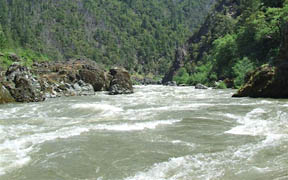-
Rogue River Rapids
Oregon has always allowed suction dredge gold mining on its rivers. It’s the modernized version of panning by hand for gold, which was quite common in some areas of the U.S. in the nineteenth and early twentieth centuries. One of the areas well known for gold mining is the southwest Oregon coast. Gold Beach got its name from the flecks of gold in the black sands of the area. Now a lot of gold mining is “recreational,” and is done not by hand, but with suction dredges. The problem with suction dredges is the way they churn up the riverbed. A principal issue is turbidity caused by the dredge activity; it clogs fish gills and coats gravel beds important for salmon feeding and spawning. This is a major problem in salmon-rich south coast rivers like the Rogue and the Chetco.
Restrictions on rampant, destructive suction-dredging are essential to protect Oregon’s huge investment in stream and salmon habitat restoration. For example, in a 2012 report, Ecotrust calculated that in the five-country area of southwestern Oregon there were 2,350 restoration projects between 2000 and 2009, creating and supporting about 1,020 jobs in local communities in desperate need of of job opportunities. The $64.3 million spent in the area for restoration between 2000 and 2009 generated approximately $113-$141 million in economic output, the majority of which stayed in the local communities, supporting local gravel companies, native plant nurseries and similar businesses.
Since 2007 the Oregon Dept. of Environmental Quality has regulated the pollution from suction-dredging. Recreational mining for precious minerals in rivers is regulated under the federal Clean Water Act. It requires a permit under the National Pollutant Discharge Elimination System (NPDES) because of the turbidity it causes. The permit covers recreational river mining that uses suction dredges having a 4-inch or smaller nozzle. DEQ regulates this small-scale mining through a general permit called the 700PM permit — meaning that an individual miner seeking a permit has been required to undertake only a very minimal site-specific analysis.
The old 700PM permit was extremely lax, but DEQ revised it to make it more protective to the environment and more enforceable. Many of the provisions sought by environmental advocates have been placed in the new permit. Among them: dredges must display an identification number; dredging is not permitted in rivers that are water-quality limited for sedimentation, turbidity or toxics; an annual monitoring log is required from each dredging operation; and discharges are prohibited from highbank and dredge operations.
The state of California placed a moratorium on suction dredge mining in 2009, and again in 2011, while it decided how best to regulate this activity which is so dangerous to salmon and other river species. This resulted in large numbers of suction dredge miners from California migrating to Oregon to pursue their hobby; and much of the increased activity was centered on the south coast. Permits issued by the Department of State Lands (DSL) for suction dredge mining skyrocketed from 771 in 2008 to 2,251 in 2012. This prompted serious concerns from commercial fishing organizations, wild salmon advocates, restoration activists, watershed councils and environmental groups. They took their concerns to the Legislature in 2013.
The result was passage of Senate Bill 838, determining that “[m]ining that uses motorized equipment in the beds and banks of the rivers of Oregon can pose significant risks to Oregon’s natural resources, including fish and other wildlife, riparian areas, water quality.” The Governor’s SB 838 Task Force met for more than a year, trying to hammer out the required new rules for legislative consideration. The 2015 Legislature failed to pass a bill implementing the Task Force recommendations, but the 2017 Legislature succeeded in passing Senate Bill 3 as amended.
The new law prohibits all motorized suction-dredge mining in Essential Salmonid Habitat as defined in ORS 196.810, which adds up to about 20% of stream miles in Oregon. Suction-dredging can still occur, with a 700-PM permit, in other areas, including habitat for bull trout and freshwater mussels. Mining in riparian areas is also allowed under the new law. While the new law is a compromise, it vastly expands protection from suction-dredge mining in areas of essential salmon habitat, the most sensitive stream reaches for salmon in the state. This protects our rivers, and all the investments made in restoring salmon habitat, for the benefit of all Oregonians and visitors.
DOCUMENTS:
- AFS Paper on Suction Dredging Effects on Fish April 2013
- Environmental Community Comments to DEQ on New Suction Dredge Permit April 2014
- Enrolled Senate Bill 838 of 2013 Oregon Legislative Session
- Idaho 2013 NPDES Permit for Suction Dredge Mining
- Governor’s Office Report on Suction Dredging Regulatory Framework November 2014
- Governor’s Office Report on SB 838 Framework Maps November 2014
- Protected Rivers Map June 2017

